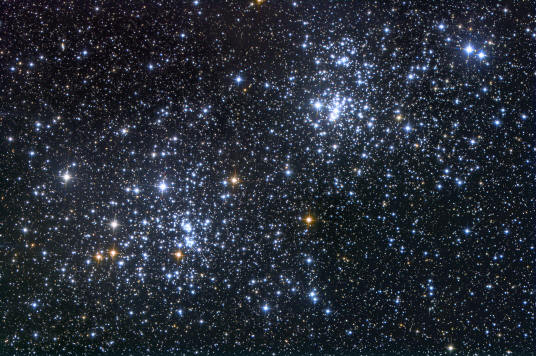The moon will be last quarter on November 3, rising in the east at midnight. On Sunday, November 1st, remember to fall back to CST as daylight savings time ends. On the morning of November 6th, the waning crescent moon passes two degrees south of Jupiter in the dawn, and then passes Mars below it a few hours later. Jupiter is much brighter,
and Mars of course reddish in color. The following morning, the moon passes only a degree south of brilliant Venus. The moon is new on November 11th. On the 13th, you might spot a slender crescent moon passing just 3 degrees north of Saturn, but they are only 15 degrees from the Sun, easily lost in the sunís glare. The moon is first quarter on November 19th, and
Full moon, the Frosty Moon, is on November 25th.
It is not a good month to spot the planets in the evening sky; catch Saturn right after sunset, low in the SW near the claws of Scorpius. It is lost in the sunís glare by midmonth. Mercury too is lost in the sunís glare all month. But in the dawn, Venus passes just south of Mars on November 3rd, and Jupiter is also well placed for
observation, west of the pair. The best meteor shower this month is the Leonids, which peak on the morning of November 18th; the crescent moon will already be set when the radiant rises in the east about midnight. While this shower has produced historic meteor storms in 1833, 1866, 1966, and 2001, the comet is not now close to us, and maybe a meteor every 3-5
minutes is the best we can hope for this year.
Setting in the southwest is the teapot shape of Sagittarius, which marks the heart of our Milky Way Galaxy, but the best view of our Galaxy lies overhead now. The brightest star of the northern hemisphere, Vega dominates the sky in the northwest. To the northeast of Vega is Deneb, the brightest star of Cygnus the Swan. To the south is
Altair, the brightest star of Aquila the Eagle, the third member of the three bright stars that make the Summer Triangle so obvious in the NE these clear autumn evenings.
Overhead the square of Pegasus is a beacon of fall. South of it is the only bright star of Fall, Fomalhaut. If the southern skies of Fall look sparse, it is because we are looking away from our Galaxy into the depths of intergalactic space.
The constellation Cassiopeia makes a striking W, rising in the NE as the Big Dipper sets in the NW. Polaris lies about midway between them. She contains many nice star clusters for binocular users in her outer arm of our Milky Way, extending to the NE now. Her daughter, Andromeda, starts with the NE corner star of Pegasusíí Square, and goes
NE with two more bright stars in a row. It is from the middle star, beta Andromeda, that we proceed about a quarter the way to the top star in the W of Cassiopeia, and look for a faint blur with the naked eye. M-31, the Andromeda Galaxy, is the most distant object visible with the naked eye, lying about 2.5 million light years distant.
To the northeast, Andromedaís hero, Perseus, rises. Between him and Cassiopeia is the fine Double Cluster, faintly visible with the naked eye and two fine binocular objects in the same field.

Perseus contains the famed eclipsing binary star Algol, where the Arabs imagined the eye of the gorgon Medusa would lie. It fades to a third its normal brightness for six out of every 70 hours, as a larger but cooler orange giant covers about 80% of the smaller but hotter and thus brighter companion as seen from Earth. Check it out on a
clear November evening, and see it the gorgon is winking at you.
If so, then instead of being as bright as Polaris, Algol fade to be only as bright as kappa Persei, the star just to its south. Look at Perseusí feet for the famed Pleiades cluster to rise, a sure sign of bright winter stars to come. In fact, yellow Capella, a giant star the same temperature and color as our much smaller Sun, rises at 7 PM
as November begins along the northeastern horizon. It is the fifth brightest star in the sky, and a beacon of the colorful and bright winter stars to come.